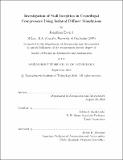Investigation of stall inception in centrifugal compressors using isolated diffuser simulations
Author(s)
Everitt, Jonathan (Jonathan Neil)
DownloadFull printable version (11.48Mb)
Other Contributors
Massachusetts Institute of Technology. Dept. of Aeronautics and Astronautics.
Advisor
Zoltán S. Spakovszky.
Terms of use
Metadata
Show full item recordAbstract
In compression systems the range of stable operating is limited by rotating stall and/or surge. Two distinct types of stall precursors can be observed prior to these phenomena: the development of long-wavelength modal waves or a short-wavelength, three-dimensional ow breakdown which is typically known as a "spike". The cause of the latter is not well understood; in axial machines it has been suggested that over-tip spillage ow has a significant role, but spikes can also occur in shrouded vaned diffusers of centrifugal compressors, where these flows are not present, suggesting an alternative mechanism may be at play. Unsteady Reynold's Averaged Navier-Stokes simulations are performed for an isolated vaned radial diffusers from a highly loaded centrifugal compressor. Key to their success is the definition of pitchwise "mixed out" averaged inlet conditions derived from the impeller exit flow field from separate single passage stage calculations. This guarantees the relevant flow features are carried into the diffuser model, particularly the spanwise profile of flow angle and total pressure. It is shown that the isolated diffuser model compares well with experimental data and time-averaged, unsteady, full wheel simulations. The stability of the flow is tested via numerical forced response experiments whereby the inlet conditions are perturbed by a total pressure forcing small in temporal and spatial extent. An unstable rotating stall precursor is observed at low diffuser inlet corrected flow, due to the spanwise non-uniform flow angle and total pressure at the diffuser inlet. The radial pressure gradient imposed by the highly swirling bulk flow leads to flow angles in excess of 90 in the shroud endwall flow. This results in shroud-side separation at the diffuser vane leading edge and a region of recirculating ow in the vaneless space. Vorticity shed from the diffuser vane leading edge convects back to the vaneless space and joins the vortical structures within the recirculating flow. This is suggested to lead to spike stall inception.
Description
Thesis (S.M.)--Massachusetts Institute of Technology, Dept. of Aeronautics and Astronautics, 2010. This electronic version was submitted by the student author. The certified thesis is available in the Institute Archives and Special Collections. Cataloged from student-submitted PDF version of thesis. Includes bibliographical references (p. 155-158).
Date issued
2010Department
Massachusetts Institute of Technology. Department of Aeronautics and AstronauticsPublisher
Massachusetts Institute of Technology
Keywords
Aeronautics and Astronautics.